A couple of years ago, as winter gave way to spring, Toyoda Ruff began to think about changing how she ate. Ruff had always been heavy, but her son, Tarik, a freshman honor student, had recently crossed the 300-pound mark, prompting Ruff to ferry him to appointments at a children’s weight loss clinic, 11 miles away in Detroit’s Midtown neighborhood, and to document everything he ate for two months. At 270 pounds, her husband, Jermaine Harris, wanted to slim down, too. Ruff was beginning to see her family’s weekly fast-food habit and visits to Golden Corral’s all-you-can-eat buffet as a problem.
As Ruff mulled over these changes, a friend cajoled her into joining a healthy cooking class at their church. Ruff was on medical leave from her job as a probation officer due to an injury, and the break gave her time to consider her meals. The more she thought about eating healthy, the more intrigued she was by a new store: Whole Foods, which had just opened in Detroit. “It was on the news. People were talking about it at church,” Ruff said. “Everybody was talking about it.”
That included people outside of Detroit, too. As the city neared bankruptcy, national media questioned why a grocer derided as “Whole Paycheck”—a nod to the chain’s longstanding strategy of charging a premium for organic, local, and sustainable food—would open a store there. Whole Foods’ answer was even more surprising: The store, said company leaders, was about social equity as much as profit.
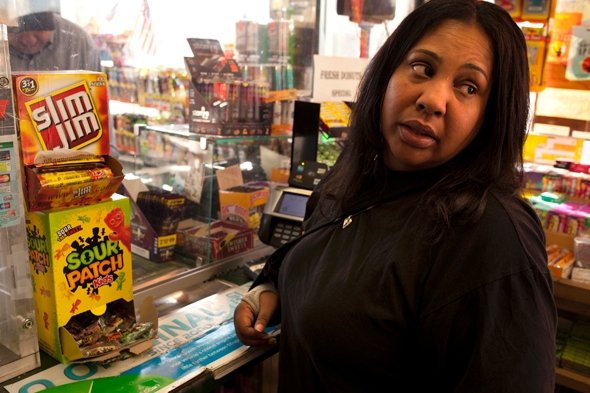
Photo by Marcin Szczepanski
“We’re coming to confront the disconnect between the accessibility and the affordability in healthy food,” declared Walter Robb, the co-CEO of Whole Foods, in an early 2012 address to Detroit business leaders. There would be lower prices, too, to make the store accessible to “all of Detroit.” Robb’s nod to the growing dietary gap between rich and poor was surprising for a man leading a company known for appealing to white, monied foodies. That April, he went even further. Addressing corporate leaders at the Milken Institute Global Conference, Robb said that at the Detroit store “we’re going after elitism. We’re going after racism.” And real success, Robb told me later, would include seeing that “health outcomes are being improved” in Detroit.
Those were big goals for any supermarket, but they were especially a stretch for Whole Foods. First lady Michelle Obama’s initiative to open new supermarkets in order to expand access to healthy foods has made it commonplace for grocers to talk about health, but it is unusual for grocers to talk about lowering prices to make healthy food more accessible. Whole Foods would almost certainly need to do that in Detroit, where more than one-third of the city lives below the poverty line. What’s more, Whole Foods’ central conceit as a company is that it sells only the best, healthiest food—which sometimes requires paying more. The Detroit store marked the grocer’s first big experiment testing whether lower-income shoppers like Ruff—a public employee with a master’s degree in social work, she is roughly middle class but sometimes struggles to pay her bills—would find that line of reasoning persuasive.
As Whole Foods prepared to open in Detroit in June 2013 tension over the city’s future was becoming palpable. Historically, racial and income inequality have broken down along the city limits, with poor, black residents in the city and rich, white residents in the suburbs, said John Patrick Leary, an assistant professor of English at Wayne State University in Detroit who frequently writes about the city’s equity issues. But as middle- and upper-class residents have moved to the city while the poor stayed poor, he said, Detroit was “becoming more of a normal city like Chicago or New York, where the superficial trappings of middle-class life are concentrated in a place where you can pretend you’re surrounded by it.” Would the store serve the audience Robb implied: the city’s working class and poor, nearly all of them black, constituting the majority of the city? Or would it fall back on its base, and just serve the influx of upwardly mobile, mostly white professionals and creatives?
Before Ruff’s first visit to Whole Foods last June, she wasn’t sure what to expect. Usually, she shopped at Aldi’s, a discount store where it took a quarter to unlock a shopping cart, and entering the store required walking past an aisle stacked 6 feet high with cookies and budget wine. For produce, she went to Randazzo’s, a local Italian market. Ruff expected Whole Foods to be a cross between Randazzo’s and Sam’s Club. When she walked in she was surprised and overwhelmed.
“It’s kind of intimidating to go in there and shop,” Ruff told me. “I just kind of walked around, but a lot of the stuff didn’t appeal to me,” she said. She didn’t see much difference—besides price—between Whole Foods’ groceries and what she bought at Aldi’s. And while many shoppers were black, as is Ruff, nearly everyone wore professional or stylish attire (or hospital scrubs); she was in a T-shirt and sweats.
Ruff was impressed, but baffled, too. She was looking for affordable, healthy food, and when she saw the salad and juice bars, the café area, the parade of samples, they seemed excessive. That first visit to Whole Foods “was like if you would go to a football game, and you’ve never been, and you have no clue as to what you’re watching,” said Ruff, who coached her sons’ pee wee football teams. “And you’re just sitting there like, ‘What the hell is going on?’ ”
To understand what led Whole Foods to put a grocery store in Detroit, you need to understand three things: The city’s reputation, its officials’ interest in changing it, and, most of all, Whole Foods’ larger aspirations.
When Robb first began eyeing Detroit in 2009, the city was mostly known for crime, abandonment, and being a place from which, as one NPR broadcast said, “grocers flee.” Dateline NBC’s Chris Hansen compared Detroit to “some ravaged foreign nation” and portrayed residents hunting raccoons for food. “There are more than 400 liquor stores in Detroit. But if you want to buy food, good luck,” he said, adding—erroneously—that the city held just eight supermarkets, all of them discount stores. Empty, savage, and foodless: This was Detroit’s reputation when Robb first went there.
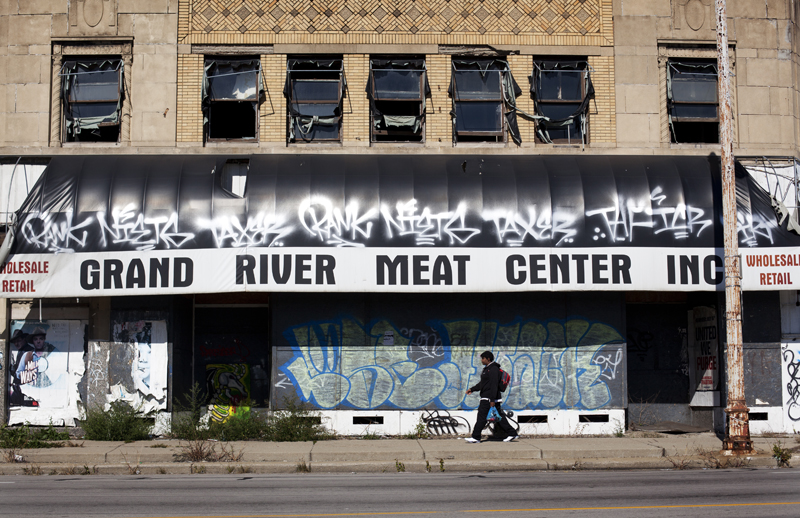
Photo by Marcin Szczepanski
Indeed, Robb might never have considered opening a store in Detroit if he hadn’t had lunch with Secretary of Agriculture Tom Vilsack, a personal friend, on a trip to Washington, D.C., shortly after President Obama—and Vilsack—took office. Robb had been paying attention to studies around food access, and watched the first lady’s initial steps around food issues with interest; maybe, he thought, Whole Foods had a role to play. When he mentioned this to Vilsack, the secretary said he had recently met with a group of black ministers from Detroit who were asking for help addressing grocery store access in their city. He offered to put Robb in touch with city officials.
Robb arrived in Detroit a few weeks later. It was January, cold and bleak, and city officials eagerly made their case as they gave him a tour. Where Robb went to Detroit to bridge the gap in food access between rich and poor, Detroit’s city planners saw Whole Foods as a way to not only serve its longstanding middle class, but to expand it. In short, they wanted the store to serve as a catalyst for gentrification. Whole Foods was more than a potential employer for the 15 percent of Detroiters who were unemployed (and the 46 percent who’d stopped looking for work entirely); and it was more than a new option for the Detroiters spending $200 million a year on groceries outside the city. It was, in the words of the city’s economic development head, a potential “game-changer” for the city.

A behind-the-scenes look at “Can Whole Foods Change the Way Poor People Eat?” In this Slate Plus interview, author Tracie McMillan talks about her ideas on food equity, the challenges she faced while reporting, and more. Try out Slate Plus for free for two weeks.
“Gentrification brings in revenue. That’s the tax base that we need to pay for city services,” George Jackson, the president of the Detroit Economic Growth Corporation, told me in the summer of 2013. (After a new mayor assumed office in January 2014, Jackson resigned.) For DEGC, a quasi-public agency in charge of overseeing economic strategy for the city, Whole Foods’ allure was less about groceries and more about development. A successful premium grocer would make Detroit more appealing to middle-class and upper-class professionals—and to executives looking for a viable place to do business—helping the city as a whole.
That calculation was central to the city’s controversial decision to coordinate $5.8 million in public subsidies and private grants for the developer Whole Foods had selected to build the store. That was enough to bring the store’s rent down to $6 a square foot, according to internal documents obtained by reporters at a local community paper, the Chaldean News (and shared with Slate). The rent, which was less than one-third of market rates last summer, served as a kind of insurance for Whole Foods, whose initial sales projections suggested that Detroit was a losing proposition. With rent that low, the store would make money even if the models were right, and sales were dismal.

Photo by Marcin Szczepanski
The store opened in June 2013 at the southern border of Midtown, a rebranded neighborhood that used to be known as the Cass Corridor, the city’s roughest skid row. Despite being in a city built for cars, the Whole Foods is an unusually walkable destination. Sitting at the corner of Mack and Woodward, it is across the street from the symphony, a block from an expanding medical complex (including Ruff’s son’s weight loss clinic), and a 15-minute walk from three college campuses. And, because it sits within five minutes of every freeway, it is also an easy stop for suburban commuters. From the store’s entryway, you cannot see any of the nearby signs of Detroit’s older reputation: burned out apartment buildings and vacant lots where the homeless gather, a check cashing joint adjacent to a liquor store. One black resident of Midtown, a marketer, compared his neighborhood’s relationship with the rest of the city to the protected section of Baghdad during the Iraq war. Midtown, he told me, is Detroit’s “Green Zone.”
Yet, to hear Robb tell it, Whole Foods also hoped to find customers outside the “college graduates and foodies” that Robb’s co-CEO, the prominent libertarian John Mackey, told me make up its traditional market base. The Midtown store is the first of several that Whole Foods is opening in mixed-to-low income neighborhoods around the country; one opened in New Orleans’ Mid-City earlier this year, and the retailer has planned stores for Chicago’s Englewood neighborhood and downtown Newark, New Jersey. When Robb and I spoke on the phone a month after the Detroit store opened, he told me “the mission of this store is to serve all Detroiters,” a group that would necessarily include the poor. And while Robb’s story of the Detroit store tends toward lofty ideals, there’s also a strong business imperative to expand the corporation’s customer base: an expansion goal of reaching 1,200 stores—nearly triple its current count—by 2020.
To succeed at Robb’s goal of reaching all Detroiters—whether for idealistic reasons of equity, or savvy ones of expanding its customer base—Whole Foods needed to do more than just turn a profit. It needed to persuade a new kind of customer that what it sold—local, organic, and sustainable—was worth seeking out. It needed, in other words, to change the food culture among the poor (or at least poorer), just as it has done among the affluent.
The second time Toyoda Ruff went to Whole Foods, she was hoping to glean a little advice. One of the biggest lessons she’d taken from the cooking class at her church, she said, was that she could afford a better diet. “When I took the cooking class I realized that … it doesn’t always have to be so expensive to eat healthy,” she said, and she was always looking for deals. So when she heard that Whole Foods was offering classes on how to shop its stores on a budget, she persuaded her friend from church, Sharon Williams, to come along.

Photo by Marcin Szczepanski
On a pleasant August afternoon, the two women piled into Ruff’s creaking Altima and drove the 11 miles from northwest Detroit to Midtown. A little after 2 p.m., they walked down a celery-green hall on the grocer’s second floor, passed a door marked “Zen Room,” and entered the classroom. Four conference tables had been pushed together, and around them sat 11 women, all but one of them black. Nearly everyone was eating the Whole Foods–brand crudités and chips that had been set out. At the front of the room stood Amanda Musilli.
“Our class today is about savvy shopping,” she began, gesturing at a PowerPoint on a wall-mounted flatscreen television. White, trim, and plainly dressed, with long brown hair and low-top Converse sneakers, Musilli had moved to Detroit in 2011 to develop community partnerships for Whole Foods, attending city council meetings and doing ground-level outreach like teaching the budgeting class—which she’d started holding two years before opening day in a storefront office.
Earlier in the year, Musilli and I had discussed city residents’ initial response to the idea of the store. “People said, well, how do you expect Detroiters to afford this?” Musilli told me. “Many times those were not Detroiters, and those were white people saying ‘How are those people going to afford your food?’ ” There is such a stark hostility between the city’s affluent suburbs and Detroit, that it seemed possible that unnamed white suburbanites had sneered at Detroiters’ interest in Whole Foods. But it also was possible, I thought, that Musilli was telling this story to deflect attention from discussions of price.
“I do want to start this talk about what’s different here, because when comparing prices of things, it’s only fair to compare apples to apples,” Musilli said at the August class, standing at the front of the room. “It’s not a fair comparison to compare our grass-fed, organic beef to factory-farmed beef.” The class waited wordlessly for her to continue, and Musilli listed the ingredients Whole Foods prohibits in food it sells: high fructose corn syrup; artificial colors, flavors, and preservatives; irradiated foods; MSG. Whole Foods’ 365 brand didn’t contain GMOs, either, she added, deftly introducing the store’s private label. “Now I don’t know if you guys know that genetically modified organisms are a concern,” she said. “We can talk about that. By 2018 … every product will be labeled and it’s going to be similar to a cigarette label, that this product may contain genetically modified organisms.” There was more friendly silence.
This general argument—a soft-pedaled version of “You get what you pay for”—is at the heart of Whole Foods’ marketing, especially its extensive new “Values Matter” campaign. But it can be a tough sell for anyone whose finances are tight. After the class, Ruff told me she was open to paying at least slightly higher prices for certain things. Leaner meats might be more expensive, but they were healthier, and she was trying to learn how to balance those things out. “It makes you feel good when you feed your family healthy stuff instead of junk,” Ruff had told me earlier in the summer.
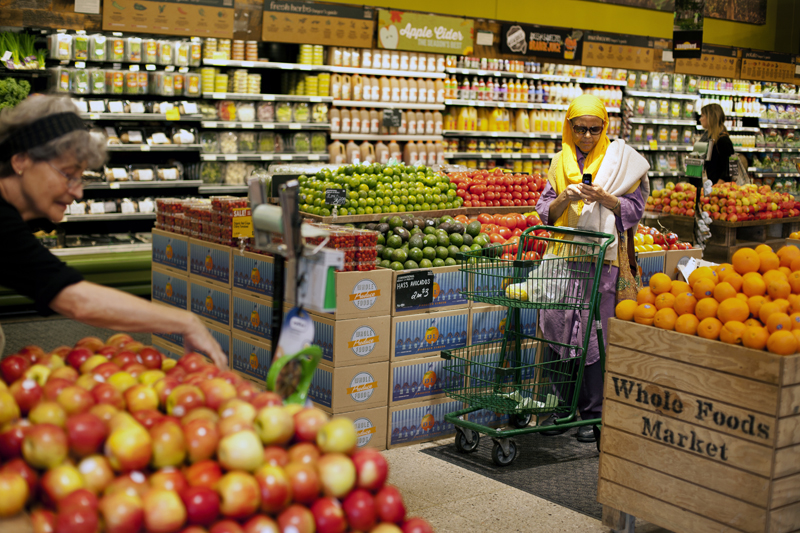
Photo by Marcin Szczepanski
As Musilli ran through her presentation, she transitioned from her “apples to apples” argument to concrete shopping tips. Little of the advice she offered would surprise anyone who already watches their budget. On a post-class tour, she counseled her students to buy whole pineapples for $2.99 each rather than pay $3.29 for a pint of pre-cut chunks; to ignore the attractive, full-price cheddar displayed next to apples that were on sale; to compare prices per ounce rather than per package in the grocery aisle. But she also frequently reminded her students that Whole Foods wasn’t just about deals, but value. At the meat counter, where boneless chicken breasts were priced $4.99 a pound, she said “it’s unfair to talk about price … if we’re not talking about quality.” When a student exclaimed at the $2.99 price for a dozen 365-brand eggs, Musilli observed that the chickens had never been in cages.
After the class broke up, Ruff, Williams, and I wandered the store, casually comparing selection and prices to what the two women said they found at Aldi’s and Save-a-Lot, where they usually shopped. We paused to look at a display of 365-brand organic applesauce cup six-packs. Ruff narrowed her eyes at the $2.99 price tag.
“For a dollar, you can get four of them at Aldi’s,” she said, referring not to the same brand, but packaged applesauce cups. Here, at Whole Foods, they were 50 cents each; at Aldi’s, 25 cents. Ruff examined the nutrition label: 11 grams of sugar. “That’s a lot,” she said to Williams.
“That’s what we learned in our other class, that you really got to pay attention to that,” said Williams.
“It’s saying low-sodium, no sugar added,” said Ruff doubtfully.
“That means it’s natural from the apples.”
“Natural sugar is better. So …” Ruff scanned the ingredient list. “It just say apples. OK. Cool.”
“That’s really cool,” said Williams.
“See, I would buy my kids this,” said Ruff. “Even though it’s a little more expensive.” Ruff ended up buying a bag of frozen edamame and some almond milk, foods Tarik’s doctor had suggested as a way to boost nutrients with modest calorie burdens. “I just figured I would pick it up, but I didn’t see anything else that was interesting,” Ruff told me later. “That was the thing. I didn’t see anything else that I really would have gotten from there that I couldn’t get for a little cheaper from another store.”

Photo by Marcin Szczepanski
Listening to Ruff and Williams, I got the impression that Musilli’s pitch about value had fallen flat. While Ruff wanted her family to eat a healthy diet, she wasn’t buying the premise that lies at the heart of Whole Foods’ ideology and marketing: that organic, non-GMO, and corn-syrup-free foods are inherently healthier than the alternative. When it came to grocery shopping, both women subscribed to basic nutrition guidelines that haven’t changed much in generations: less fat, sugar, and salt, more fruits and vegetables.
“To just go completely organic seems crazy to me,” said Ruff. “If it was a little cheaper, if it was the same price as the other stuff, maybe. But to me, it’s overpriced.” Her usual rule of thumb for determining quality was more pragmatic than the criteria listed by Musilli: “As long as it’s not spoiled, molded, or expired, I’m good with it.”
There seem to be few things that irk Whole Foods representatives more than the phrase “Whole Paycheck,” a phrase that I remember Robb casually mentioning to me as an annoyance more than once. His dislike of the phrase was the first thing that came to mind when, on the Detroit store’s opening day, Robb invited me to sit down, looked at me unblinkingly and said that if Whole Foods felt my story wasn’t going in the direction they wanted, he would stop cooperating.
Whether they knew the moniker or not, one of Detroiters’ worries about Whole Foods before it opened was price, which ranked as a top concern when the company solicited community input about the store. In my early conversations with Whole Foods for this article, I heard a lot about how prices were key to making the store accessible to residents; how the Detroit store was trying to counter its reputation for sticker-shock by limiting wine prices to $20, the same per-pound limit it set for meat; and how, in Robb’s words, those changes meant the store could serve “all of Detroit.” Even as Musilli tried to persuade shoppers like Ruff that cage-free eggs were worth the higher price, Robb was making the slightly contradictory case to reporters like me that Whole Foods’ prices were competitive with other stores.
Yet what you think of Whole Foods prices depends largely on what you consider “competitive.” When the Detroit store opened, it featured prices that were, compared to their usual prices, great deals: local, nonorganic collards were 99 cents a bunch, compared to $2.49 a bunch for organic collards at a Whole Foods in the suburbs of Detroit. And the hot food and salad bars cost $6.99 a pound instead of the usual $8.99.
But it is hard to see how a cheaper salad bar would help someone stretch his or her food dollar—or food stamps. And though the collards seemed an unusually cheap option for Whole Foods, where they were displayed atop rustic wooden crates, it wasn’t clear how their price compared to other stores in Detroit. I wanted to know more about that: How did Whole Foods compare when it came to basic staples for a Detroiter on a budget, things like eggs, yogurt, peanut butter, and cereal?
When I asked Whole Foods for a list of its competitive prices last summer, the company declined to provide one, so I compiled a list of 40 common grocery items and documented their prices at both the Detroit Whole Foods and King Cole, a neighborhood grocer in Detroit’s North End neighborhood. I borrowed Whole Foods’ preferred framework of comparing “like to like”—in other words, comparing organic items to each other—but I also checked the stores “price to price,” comparing the cheapest options available as a way of approximating the experience of a budget-conscious shopper. Based on my findings, if you were like Ruff and prioritized price, switching from King Cole to Whole Foods for groceries would cost 29 percent more for the full list of 40 items. If, on the other hand, a shopper agreed with Musilli and was willing to pay for the “value” offered by organic, Whole Foods was the clear winner, mostly because organic was an expensive rarity at King Cole, which only stocked three organic items, all more expensive than at Whole Foods.
Across the board, Whole Foods was much more competitive on price for packaged items like cereal and pasta sauce than for produce, meat, and dairy—fresh items that Whole Foods often sells only organic versions of. Packaged items at Whole Foods were about 11 percent more expensive than at King Cole; fresh were 53 percent more expensive. Those disparities have shifted slightly over the last year; when I updated prices this past September, fresh items were 58 percent more expensive at Whole Foods, packaged items 4 percent. (These findings contradict the general thrust of several recent articles touting Whole Foods’ affordability.) And while Whole Foods is experimenting with lowering its prices on produce in its flagship store in Austin, the degree of the price cuts remains unclear. At the prices I saw this fall, it’s hard to see how eating a healthy diet, with lots of produce, would be an affordable option if you were to shop primarily at Whole Foods. (To get a sense of what different items cost at four Detroit-area grocery stores—King Cole, a suburban Walmart, the Detroit Whole Foods, and a suburban Whole Foods—play around with the following interactive shopping cart of basic grocery staples based on prices I collected in September, or download the entire data set with prices, brand names, and category comparisons.)
|
Healthy Food.
Over a few days in September, Tracie McMillan recorded the cheapest food prices at two Detroit grocers (King Cole and the new Whole Foods in Midtown) and two suburban stores (the Whole Foods in Orchard Lake and the Walmart in Dearborn). Click an item to your left to add it to your shopping list and decide for yourself if Whole Foods products are worth Whole Foods prices.
Shopping List « Return to title Totals |
Interactive by Chris Kirk. Toggle illustration credits
Illustration credits: Oats by Emily Tang from The Noun Project. Butter by Tom Glass, Jr. from The Noun Project. Noodles by Julien Miclo from The Noun Project. Tomato by Noi Navve from The Noun Project. Jam by Joe Harrison from The Noun Project. Milk by Jeff Seevers from The Noun Project. Salad by Edward Boatman from The Noun Project. Ketchup by Taylor Medlin from The Noun Project. Jar by Lucas Olaerts from The Noun Project. Sugar by Claire Jones from The Noun Project. Broccoli by Amy Nicole from The Noun Project. Jar by Blaise Sewell from The Noun Project. Grapes by Thomas Hirter from The Noun Project. Cracker by Michelle Moncada from The Noun Project. Cheese by Consuelo Elo Graziola from The Noun Project. Spinach by Alessandro Suraci from The Noun Project. Cereal by Jacob Halton from The Noun Project. Flour by Mike O'Brien from The Noun Project. Cow by Olivier Guin from The Noun Project. Pepper by Crespo Crespin from The Noun Project. Can by Deuk from The Noun Project. Can by Deuk from The Noun Project. bananas by Dima Gavrikov from The Noun Project. Yogurt by Vashte Johnson from The Noun Project. Tuna by Joao Santos from The Noun Project. Question Mark by Michael Zenaty from The Noun Project. Orange by Yi Chen from The Noun Project. Potato by Yi Chen from The Noun Project. rice by Marco Galtarossa from The Noun Project. beans by Marco Galtarossa from The Noun Project. Chicken by Matthew Kennedy from The Noun Project. Shopping Cart by Márcio Duarte from The Noun Project. Oil by Dan Hetteix from The Noun Project. Spaghetti by Federico Falaschi from The Noun Project. Carrot by SuperAtic LABS from The Noun Project. Peanut Butter by Dustin Zimmerman from The Noun Project. Fish by Jens Tärning from The Noun Project.
You can see all the prices Tracie McMillan collected in Detroit from Sept. 18–22 here. To learn more about McMillan's data collection methods and data analysis, visit the Food & Environment Reporting Network's website.
When I discussed Whole Foods’ pricing with Robb in January, he repeated something I’d heard him say many times: that Whole Foods was “competitive” on price. I agreed with Robb that Whole Foods was the cheapest place in Detroit for organics, but pointed out that it could be more expensive to do all your grocery shopping there than at neighborhood grocers. Robb said he took issue with the idea that Whole Foods was more expensive than other stores. “I don’t agree with your premise there,” he said, bristling. “Whole Foods, on like-to-like items, and on basic staples, is very competitive, in any market.”
A few days later, I sent Whole Foods the price comparisons I’d gathered, asking if Robb could address the question I’d been trying to ask: What about doing all your grocery shopping at Whole Foods, not just buying select items, given these numbers? How competitive did Whole Foods see itself in that context? Within a couple days, Whole Foods sent me their own version of the list, on which the tallies had shifted: The prices for Whole Foods had dropped, and those for King Cole had risen, shrinking the markup for Whole Foods from 29 to 8 percent. When I explained that I could not use Whole Foods’ data on its competitors’ prices, Whole Foods declined to answer further questions for the story. When I pressed the issue in October, a spokesperson, Kate Lowery, told me my study was “not accurate,” but declined to explain further.
I was surprised by Whole Foods’ refusal to engage in a direct conversation about price. In my earlier conversations with Robb, he had agreed that past criticism of the store for high prices had been deserved, and he spoke eloquently about wanting to increase demand for healthier food, which he saw Whole Foods as well positioned to meet. But whenever I observed that it costs more to shop for all one’s groceries there, he repeated the mantra that Whole Foods was competitive on like-to-like items, and changed the subject to quality.
“The cheapest food is not always the best deal for you, from the health perspective. Yes, you can buy cheaper food than what we offer at Whole Foods, but there’s often a trade off,” said Robb, echoing Musilli. “I don’t know how to tell you the difference between pink slime and beef that’s been raised to our standards. It’s not the same product, but is it worth it to you?”
Whole Foods had a plan to make that case across the city. Not through newspaper circulars or television ads, not even through city officials. Instead, the grocer had brought to Detroit its own healthy eating ambassador.
The first time I saw Dr. Akua Woolbright lecture, she was in front of a crowd of about 60 people, most of them black, sitting in Sacred Heart Church on a hot, rainy summer night. Early on, Woolbright warned her audience that, as a nutritionist, she would not be advocating incremental dietary change because, “you would never say, ‘Well, it’s okay, you can kind of kill people—but do it in moderation.’ ” The crowd laughed, warming to Woolbright, who began the talk by introducing herself as the granddaughter of a rural Texas preacher and farmer.

Photo by Marcin Szczepanski
Woolbright’s ability to speak authentically in the vernaculars of the black church, holistic healers (of whom there were several at the church), and sustainable foodies—and to translate between them—make her a natural emissary for Whole Foods in Detroit. As the store’s nutritionist, she started offering classes there in 2012, a year before the store opened. She began visiting weekly from Austin, and was so taken with the city that she moved to Detroit that fall with her son. She taught classes in high schools and community centers, urging people to eat diets based on whole ingredients, dense nutrients, healthy fats, and plant-based food. Her job, Woolbright told me, was not to promote Whole Foods but to encourage healthy diets, though I noticed she sometimes failed to separate the two. Her church lecture closely tracked Health Starts Here, an in-store health promotion program, and, while Woolbright focused on food advice, she peppered the talk with casual references to the company. Still, Woolbright was persuasive when she spoke about her work: “It’s personal to me. I want to do this work anyway,” she told me. “[Whole Foods’] mission and my mission are the same thing.”
In the weeks after the store opened, Woolbright began to offer in-store hours, and so on a bright Saturday morning last summer, I spent a few hours chatting with her at a high wooden table in the bulk foods section. We had been there for about an hour when a heavyset black woman named Spencer Torry Brown, wearing sweats and an Air Jordan T-shirt, paused in front of the table. Brown’s cart held a few wrapped packages from the meat counter and a metal cane.
“She told me you could help me,” said Brown, gesturing to a woman at the meat counter. Woolbright nodded and Brown began, without prompting, to list her health problems: epileptic seizures, diabetes, COPD. She didn’t drive. She had recently found herself eating cookies and chain smoking until the wee hours of the morning. “I’m not eating the right foods, I’m eating those Oreos,” she told me later, shaking her head. “I am. I’m going through them mothers like …” Her voice trailed off, incredulous and embarrassed. “And I say to myself, something’s wrong … I have to stop. So that’s why I’m here.”
Woolbright listened to Brown thoughtfully, then disappeared into the aisles, returning with an armful of food and a game plan. She held up a can of McCann’s steel-cut oats. “In the morning you have to put something bulky, heavy in your stomach. If you don’t weigh it down you will continue to crave high calorie foods.” She suggested making a big pot of oats on Sundays, and eating from that during the week, sweetening it with bananas or maple syrup. More advice followed: Canned beans, no sodium added, are a quick way to fill up. Whole wheat pasta cooks quickly and has whole grains. Oats were good for a green smoothie; she recommended buying a NutriBullet blender at Walmart. Brown nodded appreciatively and promised to email Woolbright if she had more questions, but she left the beans and oatmeal behind.
The changes Woolbright suggested weren’t complicated, but I had a hard time seeing even myself making them. The idea of reheating porridge for the week was distinctly unappealing. Buying a $100 blender for breakfast smoothies seemed unrealistic, particularly for someone living, as Brown did, on disability checks.
On that first visit to Whole Foods, Brown didn’t buy the store’s organic cookies or other junk food, but she didn’t heed much of Woolbright’s advice, either. As I accompanied her through the store, Brown seemed excited by the options before her. She bought Balinese barbecue tofu salad from the deli, a rotisserie chicken, turkey patties with spinach, chicken shish kebabs, a peach smoothie, and—in a nod to Woolbright’s advice—some produce, including five non-organic bananas. It all looked fresh, delicious, and wholesome, but the total came to $66.05, about one-third of Brown’s monthly grocery budget. With discipline, I guessed, it could cover lunch and dinner for about a week.
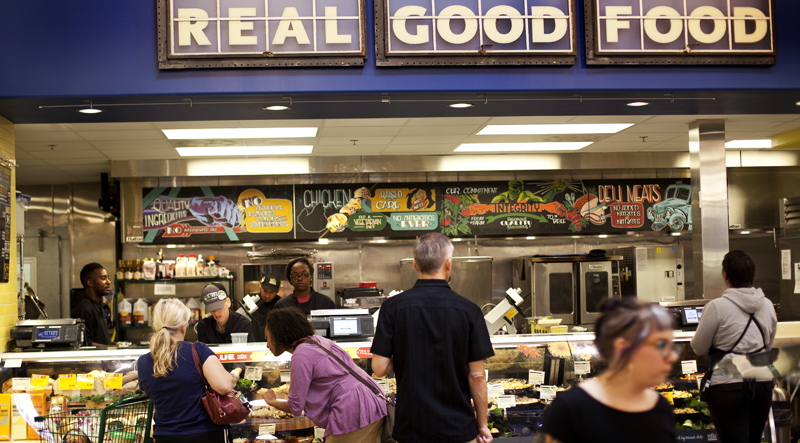
Photo by Marcin Szczepanski
The food she bought, I told her later, seemed expensive, but Brown shrugged it off. “You know, I don’t worry about expensive sometimes,” she told me later. “I mean, it can’t be over $20, but if it’s like $2 …” she paused. “I’m not a scaredy person as far as buying something.” As Brown talked, it was hard not to hear an echo of Musilli: She wanted to eat healthy foods, and she felt willing to pay more for it when she could. I got the sense that, for Brown, feeling she was both making a healthy decision and treating herself had proved irresistible.
It was difficult to get Brown to talk for long about either supermarkets or changing her habits. Instead, discussions that started off with a grocery store quickly veered off course, derailed by the problems that preceded any thoughts Brown had about health. Without a car, unable to walk far, and living in a city with unreliable public transit, Brown mostly took cabs or depended on friends and family with cars. Her medications included prednisone, a steroid that made her ravenous. (She blamed it for her Oreo binges.) When Brown moved this spring, her new apartment in Hamtramck had no stove, further limiting her meal options.
Brown shared this list of obstacles nearly every time I asked her whether she had followed Woolbright’s advice. Sometimes she would talk about how much she had liked Woolbright, but after a phone consultation last summer, when Brown took down some notes about shopping, she said they hadn’t been in touch. When Brown moved, she lost the scrap of paper on which she’d written down Woolbright’s advice.
Brown was obese and unhappy about it. “I don’t want to be this way; I don’t,” she told me. But it was difficult to see grocery stores as a primary factor in her weight problem. On one visit last summer, her breakfast had been white bread, turkey, Miracle Whip, and mustard, an attempt at following Woolbright’s suggestion to eat lean meats. Though that sandwich was not a kale salad, it was also not a Big Mac and fries. When I returned this fall, I asked Brown how she was doing with following Woolbright’s advice, and she showed me to a lidless Tupperware in her refrigerator with corn kernels and green beans. “I’m a veggie person, really. I like broccoli and beans and corn,” she said. What little other food she had looked nominally healthy: chicken thighs, eggs, cheese slices, a jug of water, and a jug of Minute Maid punch (three for $5 at her neighborhood supermarket), condiments in the door. The problem, she said, was her sweet tooth. Last summer, it had been the Oreos; this year, money was tighter, so it was pancakes and syrup.
What seemed to be tripping Brown up wasn’t knowledge about nutrition so much as a debilitating sense that anything she tried to change—what she ate, how she spent her days—could spiral out of control, whether because of depression or finances or transport or health. Going to the store meant worrying about getting someone to drive her, she told me, and once there she had to worry about the driver getting upset with her for taking too long. Then she had to worry about trying to cook—she had only a microwave and a George Foreman grill—and even so she couldn’t stand long enough to cook much, anyway. At nearly 300 pounds, getting to a healthy weight felt insurmountable. Most days it felt easier, more predictable, less likely to result in failure, to just keep doing what she was doing.
It can be tempting to disparage Brown for her tendency to get overwhelmed by the myriad issues—health, transport, money—that she faced, but recent research suggests that it’s a problem common across all levels of education and social class. “When you are struggling with lots on your mind, that just leaves less mind for other things in everyday life,” said Eldar Shafir, a behavioral researcher at Princeton University. Shafir calls this tendency “bandwidth poverty,” which he and Harvard economist Sendhil Mullainathan documented in multiple experiments for their book, Scarcity. Whenever most people face multiple problems at once, they focus on the most urgent one—and may do fairly well with it. But when it comes to everything else, said Shafir, there’s just not enough brainpower to go around. “You’re going to get both depleted and distracted, and forgetful, and not do things exactly right,” said Shafir. It is easy to see an example of that in the way that Brown had shopped so healthfully after speaking with Woolbright—yet budgeted so poorly.
Brown told me she visited Whole Foods twice last year. She liked that it was clean and pretty and bright, that she could sit down, have a nice snack, maybe meet people. She liked its wholesome, healthy aura. None of that was true of Walmart or her local supermarket or the corner store where she bought cookies. “Whole Foods is great,” said Brown. “It make you feel … it put you in a right perspective of yourself being healthy.” What she liked about Whole Foods, it turned out, were the same things that middle-class people liked.
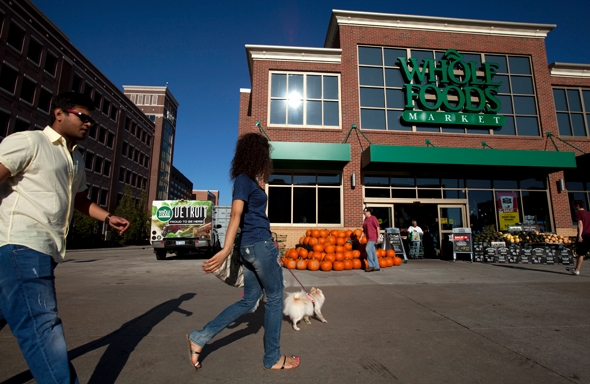
Marcin Szczepanski
When Woolbright and I discussed Brown’s shopping trip, I commented that Brown had bought food that looked healthy, but was fairly expensive. “Right, right,” said Woolbright. “That’s a different question,” she said, shifting our discussion from cost to quality. “We’re not talking about expense right now, we’re talking about nutrition choices,” she said. Her role as a nutritionist, as she saw it, was to give Brown information about the healthiest choices she could make; it wasn’t any of her business to tell Brown how to prioritize her budget.
“People make assumptions about, ‘Oh, they’re on welfare. I can’t believe they bought bottled water’ ” or other expensive things, said Woolbright. “I don’t make those assumptions for people.” I heard an echo of Musilli’s story about white suburbanites’ assumptions about Detroit. There was merit to what Woolbright said, but Whole Foods seemed to have settled on a media strategy of deflecting questions about price by suggesting that it is paternalistic, if not classist and racist, to ask whether its food is affordable to the poor.
If you do ask that question, though, you find that the healthiest foods at Whole Foods—the produce, the meat, the dairy—are all sold at prices that exclude the poor, Brown included, from regularly shopping there. Whatever “value” Whole Foods may offer, it is hard to avoid the conclusion that a company selling “healthier” food at a 29 percent markup widens the class divide in diet and health rather than narrowing it.
Still, Woolbright was right about desire. “I feel like people want to do better; they want to do better,” she said. This was clearly true of Brown: She wanted to eat, and feel, better—and she saw Whole Foods as a way to do both when, and if, she could afford it.
This September, Toyoda Ruff settled into an upholstered chair while her husband finished his dinner: a mound of lettuce, tomatoes, and other vegetables. Ruff was planning to eat later, probably some vegetable-beef soup she had made over the weekend. “I’ve been to the Whole Foods stores a couple of times—the almond milk, the stuff that was on sale,” said Ruff, holding a toddler nephew on her lap. “But I didn’t really pick up the meat or a lot of the vegetables, they were kind of expensive,” she said; she still favored Aldi’s. Of Whole Foods, said Ruff, “That’s the bourgie store,” she said. “I just wonder how many people come from the ‘hood and go shopping at Whole Foods’ store. I bet you it’s not a lot.”

Photo by Marcin Szczepanski
I was curious about that, too. Knowing how many of Whole Foods’ customers were actually poor would give an indication of the progress Whole Foods had made toward its goal of serving “all Detroiters.” In January, I asked Whole Foods how their Detroit store’s sales from SNAP—food stamps—compared to the company’s other stores; nearby independent grocers had told me 75, even 80, percent of their sales came from SNAP. Though Whole Foods declined to share specific numbers, Robb did say that SNAP sales in Detroit were an impressive five or six times the chain’s average, suggesting they had reached more of the poor than at their other stores. A source who was familiar with the Detroit store and its initial sales performance, and who declined to be named for professional reasons, told me that Whole Foods averages about 1 or 2 percent of sales from SNAP nationwide. If both Robb and my source are correct, 5 to 12 percent of Whole Foods’ Detroit sales are from SNAP. Since 38 percent of Detroit residents make use of the SNAP program, this estimate suggests the store isn’t reaching a cross section of the city, but a targeted, upper-income niche.
Indeed, last summer, when all the numbers had been crunched after the opening crush of business, the store found itself considering selling more expensive items, not cheaper ones. The top seller in the bakery department had been a single cupcake, baked in a half-pint jar. It sold for $6. Customers had been asking for more lamb, better cuts of meat, and higher quality wine. The busiest time at the store, Banks told me, was lunch hour, when office workers flooded the store—it is one of the few places for quick take-out within walking distance of the medical complex next door. Last November the store added a breakfast bar with $5 breakfast burritos. By autumn, bottles of wine topped out at $42, and meats at $30 per pound, instead of $20. This slide toward higher prices suggests that Whole Foods was having more success with its traditional customers than with lower-income ones.
None of this repudiates the idea that Whole Foods is a broadly positive thing for Detroit. In addition to a grocery store, the city got the gentrification signifier that it sought. Development in Midtown—and elsewhere in the city—has continued to expand, and local officials have told me Whole Foods’ success has made it easier to persuade companies to give Detroit a try. At last count, the store had created 180 jobs with wages well above the federal and state minimums. Robb has spent his own money in town, paying for new signs at the farmer’s market, persuading his suppliers to donate $150,000 in equipment to a commercial kitchen for food entrepreneurs, and hosted a benefit to raise money for the project. Even Ruff and Brown, who have little use for the store, told me they are glad it’s there.
In strictly financial terms, Whole Foods has succeeded in Detroit. Sales there have been double the initial projections, and despite Whole Foods’ reputation as a store for wealthy whites, my visits to the store suggest that its customer base reflects the fact that Detroit is majority black. When Robb was in Detroit this past September for a conference to drum up corporate interest in the city, he said the chain is looking to open a second store there.
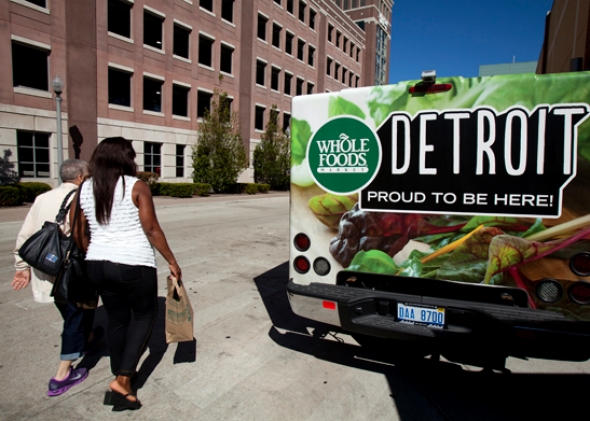
Photo by Marcin Szczepanski
But if you consider Robb’s broader initial goals—to reach families just trying to eat healthier, to make truly healthy food truly accessible to a broad swath of the city, to tackle the class divide in health—Whole Foods hasn’t gotten very far. Robb’s eloquent talk aside, Whole Foods isn’t too preoccupied with finding a market among shoppers like Ruff and Williams, for whom the pitch that cage-free and genetically modified are healthier than other food doesn’t merit the markup. Shoppers wanting simple, affordable healthy food, rather than an aspirational product, have better options elsewhere. And for indisputably poor people like Brown, who aspire to buy what Whole Foods sells, the prices simply aren’t low enough to work. This is not to call into question the sincerity of Robb’s desire to improve health outcomes in Detroit, but rather the impracticality—if not disingenuousness—of tying such a broad social goal to a marketing plan that requires, by definition, spending 29 percent more on your groceries. For anyone looking to address health and diet disparities, the lesson from Whole Foods in Detroit may well be that the problem is not food, but poverty. And that is a problem that requires more than a supermarket to solve.
Truthfully, that is something that Robb knows. When I last talked to Robb, in January, I believed him when he told me he was troubled by the “the idea that health is, somehow, the province of the rich—which it’s not,” and how the “disparity [in access to healthy food] is unacceptable from a moral perspective.” Those things, I told him, troubled me, too.
I asked Robb what that meant for Whole Foods, where grocery shopping was more expensive. “Ultimately customers get to choose. It’s a free market, and we’re going to present our choices, and then people are going to decide if they’re worth it or not,” said Robb. Ruff, Brown, the rest of Detroit, even the rest of America—all were welcome to peruse the aisles and decide whether the grass-fed beef was worth the markup over pink slime. “You know, we’re not miracle workers,” Robb told me. “We’re just a grocer.”
This article was produced in collaboration with the Food & Environment Reporting Network, an independent, nonprofit news organization producing investigative reporting on food, agriculture and environmental health.

